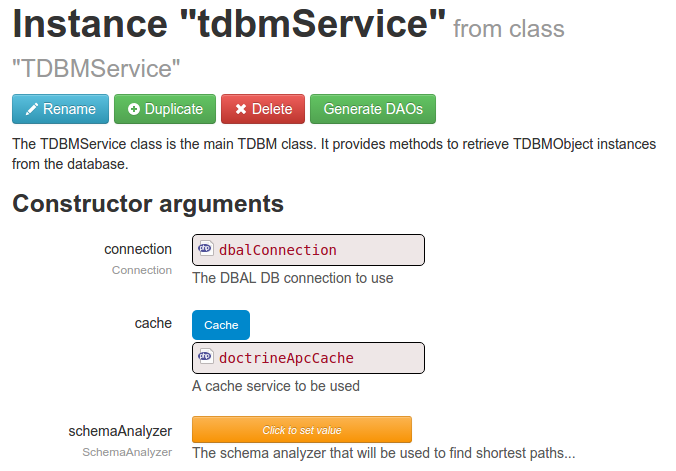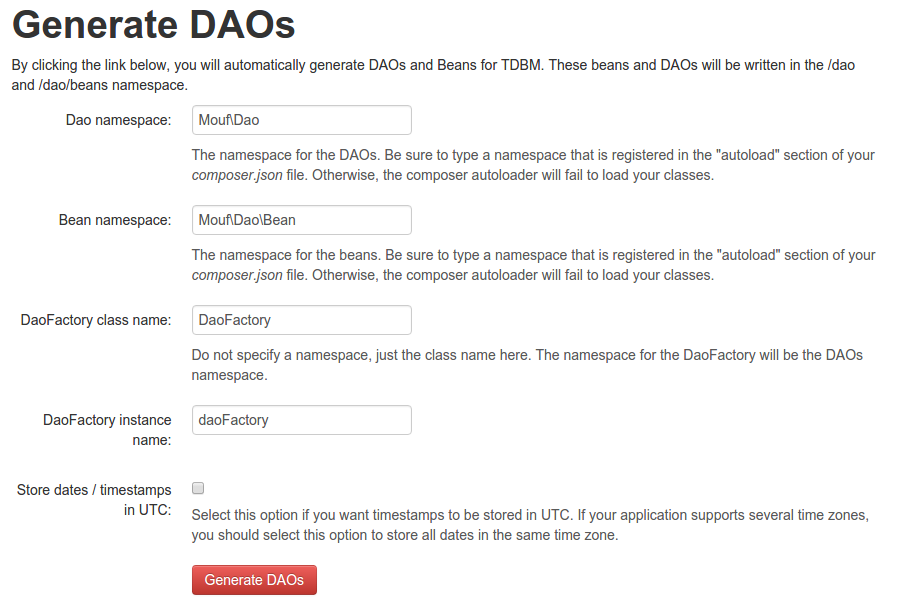Generating DAOs
Although TDBM can be used without generating DAOs, the easiest way to use it is to generate DAOs using Mouf. This feature will allow you to cleanly separate the database code (that you will put in DAOs) from the rest of your code.
Getting started
The tdbmService instance
During installation, TDBM will generate a "tdbmService" instance.
This instance is already configured, but should you need to modify the configuration, you need to know that
a TDBMService must be connected to a database connection, and to a caching service.

Setting up the cache service
By default, Doctrine's ApcCache service is used.
TDBM requires a cache in order to store database related data. Indeed TDBM stores in cache the structure of the database,
and relies heavily on declared foreign keys to perform the "smartest" queries. Instead of querying the database for those
foreign keys, it will query them once, and put them in cache. This means that if you modify the database model, you will
need to purge the TDBM cache.
TDBM relies on Doctrine cache system. You are free to choose the best one amongst the Doctrine services
implementing the Cache interface.
Generating the DAOs
In this chapter, we will see how to generate DAOs and beans, using the TDBM_Service instance.
This process is automatically done when you install the package, but should you modify the data model, you will need to
regenerate the DAOs.
First, go to the "tdbmService" instance page (select it from the "View declared instances", or use the full-text search feature).
On the right part of the screen, select the "Generate DAOs" link.

On this screen, you can choose the namespace that will contain the DAO classes, and the namespace that will contain the Beans. Also,
a DAOFactory object (that allows easy access to each DAO) will be generated. Let's just keep the default settings and click the
"Generate DAOs" button.
That's it, we generated all the DAOs for our database. Let's have a closer look at what was generated.
Note: if you are using Eclipse, we strongly recommend you to refresh your project, to load the new classes.
The DAOs structure
For each table in your database, TDBM will generate a DAO and a bean. The DAO is the object you will use to query the database. Each row of the database will be mapped to a bean object.
Both DAOs and beans are divided in 2 parts. Let's assume you have a "users" table. TDBM will generate those classes for you:
UserBaseDao: the base class that contains methods to access the "users" table. It is generated by TDBM and you should never modify this class.UserDao: this class extends UserBaseDao. If you have some custom requests, you should perform them in this class. You can edit it as TDBM will never overwrite it.UserBaseBean: the bean mapping the columns of the "users" table. This class contains getters and setters for each and every column of the "users" table. It is generated by TDBM and you should never modify this class.UserBean: this class extends UserBaseBean. If you have some custom getters and setters, you should implement them in this class. You can edit it as TDBM will never overwrite it.
Let's now have a closer look at the methods that are available in the "UserDao" class:
public function save(UserBean $obj): saves aUserBeanobject in databasepublic function findAll(): returns all users records as an array ofUserBeanobjects.public function getById($id, $lazyLoading = false): Get aUserBeanspecified by its ID (its primary key)public function delete($obj, $cascade=false): Deletes the UserBean passed in parameter. If$cascadeis set to true, it will delete all objects linked to$obj.
The last 2 functions are protected. It means they are designed to be used in the UserDao class.
protected function find($filter=null, $parameters = [], $orderbyBag=null): returns a list of users based on a filter bag (see theTDBM_Servicedocumentation to learn more about filter bags). You can also provide an order, and an offset / limit range.protected function findOne($filter=null, $parameters = []): this has exactly the same purpose as find except it returns only 1 bean object instead of a list of bean objects.
Found a typo? Something is wrong in this documentation? Just fork and edit it!